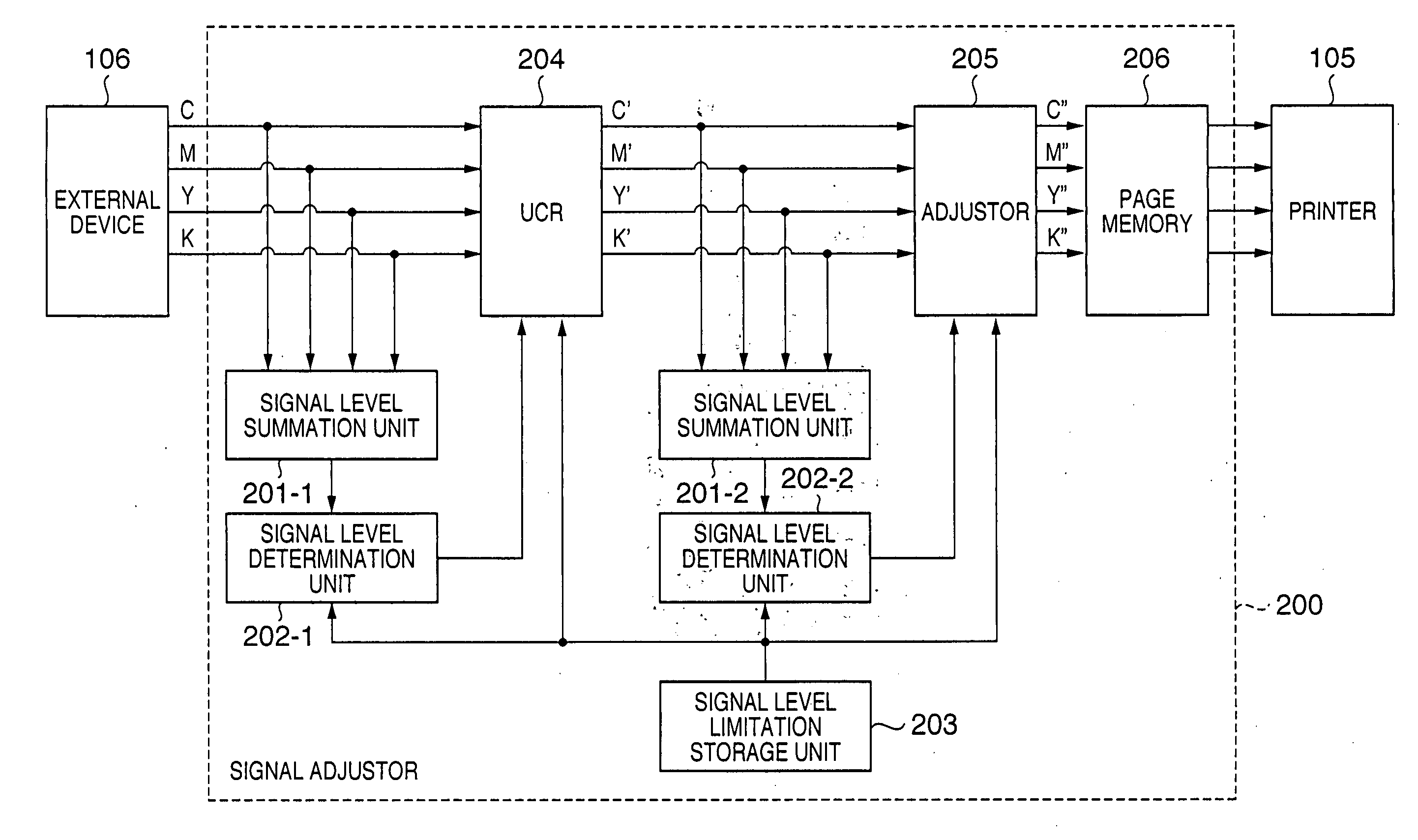Recording material consumption control for an image forming apparatus
a technology recording material, which is applied in the field of recording material consumption control of image forming apparatus, can solve the problems of reducing image quality, excessive toner or ink consumption, and deterioration of toner or ink devices, so as to improve output image reproducibility and limit the amount of toner or ink
- Summary
- Abstract
- Description
- Claims
- Application Information
AI Technical Summary
Benefits of technology
Problems solved by technology
Method used
Image
Examples
first embodiment
(First Embodiment)
FIG. 1 is a block diagram showing an example of the construction of a color copier 100 according to the first embodiment of the present invention.
First, in a normal copy operation, RGB signals of an original image output from a scanner 101 are input and masked by an input masking unit 102 of an image processor 107, are logarithm-converted by a logarithm converter 103 and converted into C, M and Y (CMY) image signals. These CMY image signals are then subjected to under color removal and output masking processed by a UCR output masking unit 104, and output to a printer 105 as CMYK image signals.
In a normal copy operation, because the UCR amount and a masking coefficient are set at the UCR output masking unit 104 in order to keep the level of the image signals within the processing capacity of the printer 105, there is no input to the printer 105 of image signals with levels exceeding the processing capacity of the printer 105.
Next, a description is given of an ...
second embodiment
(Second Embodiment)
Next, a description is given of a second embodiment of the present invention with reference to FIG. 5.
In the second embodiment, the way in which the adjustment level α is calculated using the adjustor 205 (step S18) and the way in which the signals are calculated (step S19) are different from those of the first embodiment. Other than that, the same processes as shown in FIG. 3 are carried out in FIG. 5, including step S13 in FIG. 5 in which the same process as in step S3 in FIG. 3 is carried out. Therefore the same reference numerals are used and a description thereof is omitted here.
In the first embodiment in step S8 the adjustment level α is calculated using equation (6). On the other hand, the adjustment level a is calculated using equation (8) in the second embodiment (step S18).
α=C_Max / Sum—In′ (8)
In step S19, the signal value of signal K′ is also decreased at the same proportion as are the other signals C′, M′, Y′ using the calculated adjustment leve...
third embodiment
(Third Embodiment)
Next, a description is given of a third embodiment of the present invention.
In the third embodiment, the under color removal amount Ucr in step S13 in FIG. 5 is calculated using the following equation (9):
Ucr=Min((Sum—In−C_Max) / 2, R×Min(C,M,Y)) (9)
It should be noted that R indicates the under color removal level, which is either specified by the user or stored previously in the apparatus. Moreover, 0≧R≧1. However, Ucr=0 when the output results of the signal level determination unit 202-1 show that the signal level is within the limiting value.
In this method of calculating Ucr, in contrast to the first and second embodiments in which the amount of toner used is zero for any single color, the signal levels leave a minimum color at a constant proportion. Otherwise, the third embodiment is identical to the first embodiment and therefore a description thereof is omitted here.
FIGS. 7A-7C schematically express changes in CMYK signal levels due to processing by t...
PUM
 Login to View More
Login to View More Abstract
Description
Claims
Application Information
 Login to View More
Login to View More - R&D
- Intellectual Property
- Life Sciences
- Materials
- Tech Scout
- Unparalleled Data Quality
- Higher Quality Content
- 60% Fewer Hallucinations
Browse by: Latest US Patents, China's latest patents, Technical Efficacy Thesaurus, Application Domain, Technology Topic, Popular Technical Reports.
© 2025 PatSnap. All rights reserved.Legal|Privacy policy|Modern Slavery Act Transparency Statement|Sitemap|About US| Contact US: help@patsnap.com



